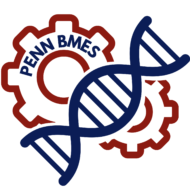James Howard, Ryan Wade &, Dr. Jason Burdick
Our first Research Spotlight was written by James Howard, a junior working in Dr. Jason Burdick’s lab. If you would like to learn more about his work or the other research being conducted by the Burdick lab, feel free to visit their lab website.
The goal of the research was to form a mathematical model that related the strength of hydrogels with a hyaluronic acid (HA) backbone to the enzymatic degradation rate of that hydrogel. Ultimately, this model could be used for future studies that apply to cell culturing, cell delivery, and growth factor delivery. Hydrogels are cross-linked polymers that can be used for drug delivery and tissue engineering applications. The hydrogels generated in this research degrade when the cross-links in the gel are cleaved enzymatically, namely by matrix metalloproteinases that are naturally secreted by cells. The degradation rates of these gels can be characterized by the amount of hyaluronic acid they release. Enzymatically degradable and non-degradable hydrogels were created first by attaching either a pre-engineered degradable or non-degradable peptide to either 2 weight % or 4 weight % maleimide modified HA. In mechanical property analysis, the hydrogels were tested in a rheometer for 30 minutes to determine the storage modulus (resistance to shear force) of the gels. Read more…
